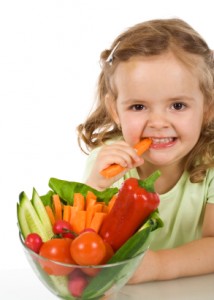 When you say the words, “kids” and “healthy foods,” do you quake a little inside? Do you secretly laugh, thinking to yourself that the two concepts just don’t mesh? Do you bemoan the fact that your kid, when pressed for a vegetable choice, picks french fries every time? Do you think to yourself, “Well, maybe he’ll eat vegetables when he’s a grown up?”
When you say the words, “kids” and “healthy foods,” do you quake a little inside? Do you secretly laugh, thinking to yourself that the two concepts just don’t mesh? Do you bemoan the fact that your kid, when pressed for a vegetable choice, picks french fries every time? Do you think to yourself, “Well, maybe he’ll eat vegetables when he’s a grown up?”
These are all things that people have said to me when I ask about the eating habits of their children. Many parents despair, give up and forget about offering healthy foods. They stick with so called “kid foods” – Pop Tarts, Lunchables, sodas and chips. In reality, children do often have more finicky palates and less tolerant taste buds. It can take a lot of time and encouragement, but these difficulties can definitely be overcome. Here are some tried and true tips to improve your children’s dietary habits.
- Rather than wait until your kids are grown up to try to encourage them to eat healthy, begin now. As early as possible. The expression “There’s no time like the present” exists because it’s true. Start young. Give your baby and toddler as varied of a diet as possible.
- Offer. Offer. And Offer Again. It can take as many as 21 exposures to a new food for a child to welcome it. Don’t be discouraged, just keep trying. If a cherished older sibling, cousin or grandparent likes a certain food, play that up to your kid.
- Talk about it. What’s in a chip? What’s in broccoli? What does your body need to play an hour of soccer? How will the cupcakes make you feel in the middle of your baseball game? Kids are smart, and even though they might not seem like they are listening, these lessons sink in. Ask your child what veggies she does like, and make sure to have them on hand. My own kids will eat two or three cucumbers and a container of grape tomatoes at one sitting.
- Snack time is the right time. My kids know that when they come
 home from school, they have a wealth of snack options. Any fruit or vegetable we have in the house is fair game as well as any yogurt, cheese stick or half a sandwich that they want to prepare. I also pass out the raw veggies that I’m chopping for dinner to those who just.can’t.wait for dinner. It’s amazing how many carrot sticks they will eat before the meal begins.
home from school, they have a wealth of snack options. Any fruit or vegetable we have in the house is fair game as well as any yogurt, cheese stick or half a sandwich that they want to prepare. I also pass out the raw veggies that I’m chopping for dinner to those who just.can’t.wait for dinner. It’s amazing how many carrot sticks they will eat before the meal begins.
- Don’t bring it in the house. This applies to all junk food. If it’s not a healthy choice, and you don’t want your kids snacking on it, don’t buy it.
- Don’t reward. Oh, this is tough. We all grew up with “If you finish your dinner, you can have dessert!” and “If you stop crying, I’ll give you a lollipop!” These behaviors have been proven to cause disordered eating patterns. Dessert is offered because it is offered, not as a reward for joining the Clean Plate Club.
- Let them see you make the right choices. Walk the walk, and talk the talk. Don’t linger in the kitchen, rooting around to find some chocolate. Eat your salad. Make a smoothie. Try the brown rice. Kids are always watching.
- Cook together. Some of my most adventurous eaters are the ones who like to cook with me. While chopping veggies for stir fry, sample, and allow your kid to do the same. Kids who cook are more likely to try what they’ve made.
- Make eating out a rarity, not a daily event. Think back to your own childhood. How often did you eat out? For me, it was a yearly event. Studies have shown that meals prepared outside the home are higher in fat, calories and sodium. I want my children to learn that food is something to be created to fuel my body, not something ordered by yelling into a speaker and eaten in the car.
What are some ways that you’ve taught your children healthy eating habits?
Also Read:
Positive Reinforcement Encourages Kids to Eat More Vegetables
Sneaking Vegetables into Food Cheats Kids
